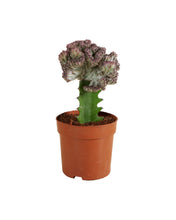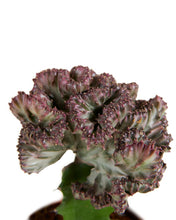Euphorbia lactea 'Cristata', commonly known as coral cactus or crested euphorbia, is a distinctive succulent valued for its wavy, fan-shaped stems that resemble sea coral or a brain-like formation. This cultivar of Euphorbia lactea exhibits undulating, often mottled green stems, sometimes with white marbling or reddish edges. It creates a unique and sculptural focal point in any collection. Despite its common name, it is a succulent, not a true cactus. It is a member of the Euphorbiaceae family.
The genus name Euphorbia is thought to honour Euphorbus, a physician to the King of Mauretania. Lactea refers to the milky sap produced by the plant. 'Cristata' indicates the crest-like, mutated growth form specific to this cultivar.
Light: Euphorbia lactea 'Cristata' thrives in bright conditions, including some direct sunlight. It generally performs best with at least four hours of sun exposure daily. When grown indoors in the UK, a window facing east or west is often suitable, providing morning or afternoon sun while offering some protection from the most intense midday sun.
Water: Water sparingly. This succulent requires its potting mix to become entirely dry between waterings. During the active growing season (spring and summer), water thoroughly, ensuring all excess moisture drains away. In autumn and winter, when the plant is dormant, significantly reduce watering, allowing the mix to remain dry for longer periods. Overwatering is a frequent cause of rot.
Soil: A potting mix that drains exceptionally well is crucial. A specialised cactus or succulent mix is ideal. This type of mix will help prevent waterlogging, which is vital for the plant's health.
Fertilising: This plant is not a heavy feeder. During the growing season (spring and summer), a diluted liquid fertiliser made for cacti and succulents can be applied monthly. Reduce or stop fertilising during the dormant period.
Temperature: Euphorbia lactea 'Cristata' prefers warm, dry conditions and is not tolerant of frost. It thrives in typical room temperatures, ideally between 10-23°C (50-75°F). It must be protected from temperatures below 10°C (50°F), as this can cause lasting harm. If grown outdoors in the UK, it should be brought inside before temperatures drop.
Humidity: Standard household humidity levels are sufficient. This plant prefers dry air and does not need high humidity.
Growth Habit: It is a slow-growing succulent, forming a distinct, crested, and often fan-shaped structure. It typically stays a manageable size when grown in containers.
Toxicity: All parts of Euphorbia lactea 'Cristata' contain a milky white sap (latex) that is poisonous. This sap can cause skin irritation, itching, and blistering upon contact, and severe irritation if it enters the eyes or mucous membranes. If consumed, it can cause stomach discomfort, sickness, vomiting, and diarrhoea in humans and pets. Always use gloves and exercise extreme care when handling or pruning this plant, and place it in a secure location away from children and pets.



